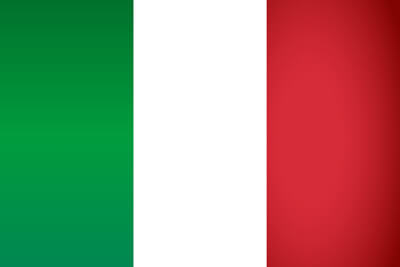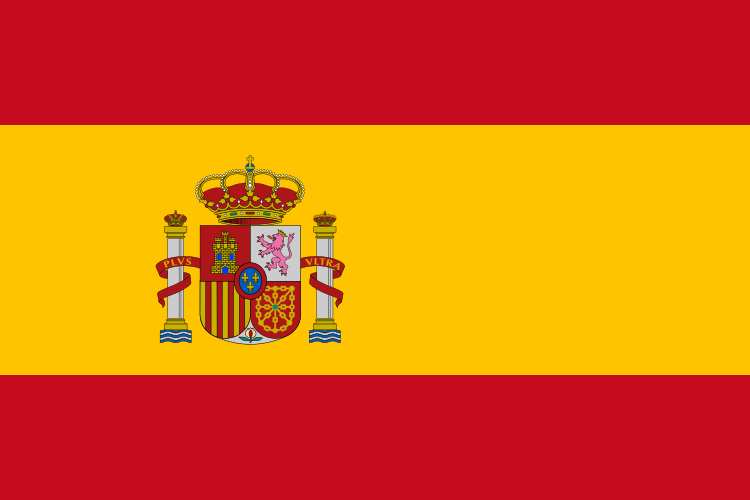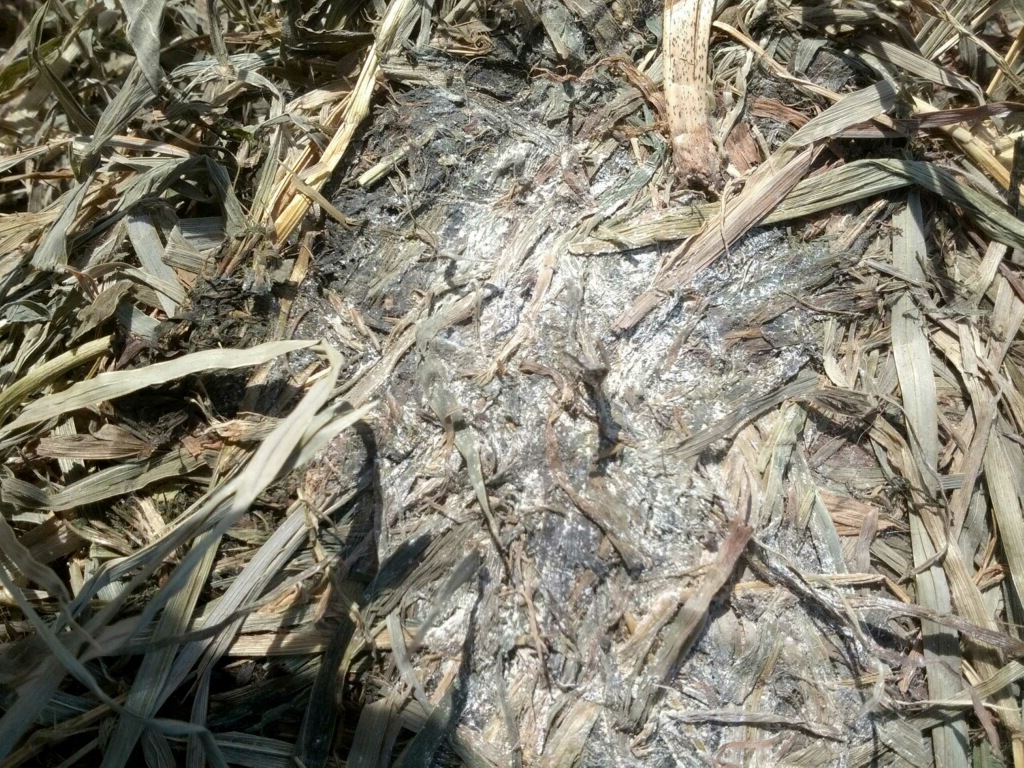 Recently I was sitting on a plane reading an article in National Geographic about mites and how these tiny creatures have been found on almost all humans. They live in our hair follicles and eye lashes and other places on our body without us ever being aware of them. Which is a very good thing as far as I’m concerned because I’m not too keen to think about these little creatures and the intimate relationship they have with me. The article got me thinking about the horse’s digestive tract and the things that can lurk there. Things that are always there and generally do no harm, that we don’t often consider but that have the potential to cause illness as well negatively impact health and reproduction.
Recently I was sitting on a plane reading an article in National Geographic about mites and how these tiny creatures have been found on almost all humans. They live in our hair follicles and eye lashes and other places on our body without us ever being aware of them. Which is a very good thing as far as I’m concerned because I’m not too keen to think about these little creatures and the intimate relationship they have with me. The article got me thinking about the horse’s digestive tract and the things that can lurk there. Things that are always there and generally do no harm, that we don’t often consider but that have the potential to cause illness as well negatively impact health and reproduction.
Endotoxins and Mycotoxins in Equine Feed
January 30, 2015
Posted by Dr. Clair Thunes in Nutrition
Feeding to Avoid Angular and Flexural Limb Deformities in Foals
August 03, 2014
Posted by Dr. Clair Thunes in Nutrition
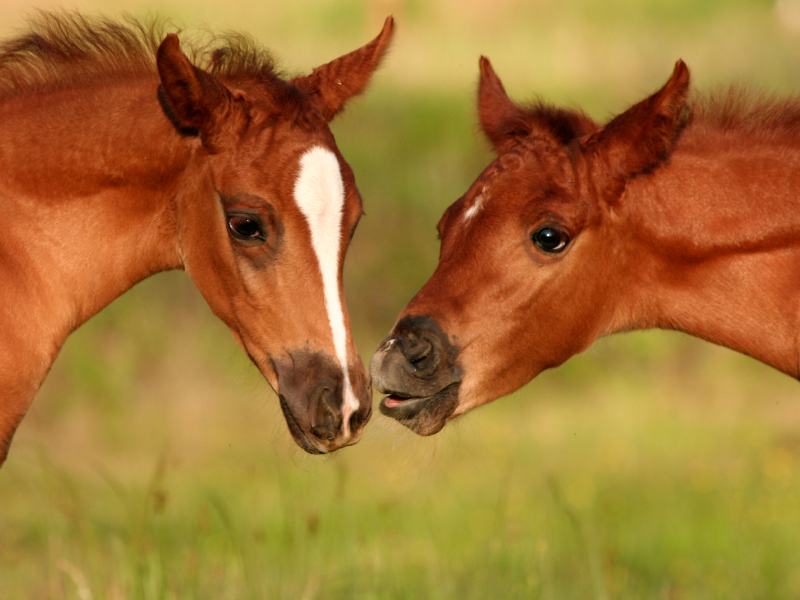 After months of anticipation finally your foal arrives. You carefully selected a sire that would complement your mare with the goal of producing a foal with the perfect conformation to succeed in the discipline of your choice. However, as the foal stands to take its first wobbly steps you realize something is less than perfect. The fetlocks are buckled over in front so that the foal gives the appearance of standing on tiptoes and being very over at the knee. You realize the foal has contracted tendons, a form of flexural deformity.
After months of anticipation finally your foal arrives. You carefully selected a sire that would complement your mare with the goal of producing a foal with the perfect conformation to succeed in the discipline of your choice. However, as the foal stands to take its first wobbly steps you realize something is less than perfect. The fetlocks are buckled over in front so that the foal gives the appearance of standing on tiptoes and being very over at the knee. You realize the foal has contracted tendons, a form of flexural deformity.
Nutritional Considerations for the Breeding Stallion
January 13, 2014
Posted by Dr. Clair Thunes in Nutrition
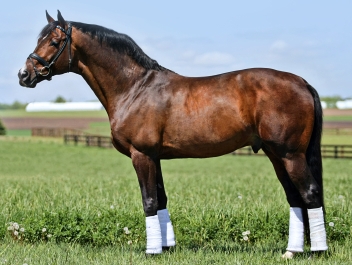 While mares are the foundation of a breeding establishment, the stallions are often considered the stars of the show with vast sums of money spent on promoting their virtues. Therefore, it is important that they are physically fit, in top health, able to perform on demand whether for live cover or collection for later artificial insemination. Nutrition plays an important role in insuring maximum performance potential and yet compared to the level of research attention paid to the feeding of broodmares and growing young stock, the nutritional needs of the stallion have received far less scientific attention.
While mares are the foundation of a breeding establishment, the stallions are often considered the stars of the show with vast sums of money spent on promoting their virtues. Therefore, it is important that they are physically fit, in top health, able to perform on demand whether for live cover or collection for later artificial insemination. Nutrition plays an important role in insuring maximum performance potential and yet compared to the level of research attention paid to the feeding of broodmares and growing young stock, the nutritional needs of the stallion have received far less scientific attention.
Performing a Hay Analysis
July 24, 2013
Posted by Dr. Clair Thunes in Nutrition
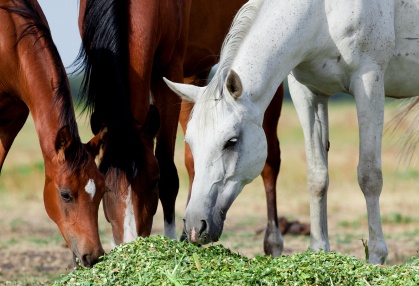 Regardless of the horse, forage should be the foundation of their ration. Even those with the best pastures will find that at some point in the year they will likely need to substitute another form of forage and the most common form of pasture replacement is hay. With forage as the foundation, all other components of the diet should build on the forage adding what may be lacking and improving the overall balance of certain nutrients. While forages can be assessed visually, the only way to accurately know the nutrient content of your forage is to have it tested by a lab.
Regardless of the horse, forage should be the foundation of their ration. Even those with the best pastures will find that at some point in the year they will likely need to substitute another form of forage and the most common form of pasture replacement is hay. With forage as the foundation, all other components of the diet should build on the forage adding what may be lacking and improving the overall balance of certain nutrients. While forages can be assessed visually, the only way to accurately know the nutrient content of your forage is to have it tested by a lab.
Is Your Stallion at Risk for Ulcers?
March 19, 2013
Posted by Dr. Clair Thunes in Nutrition
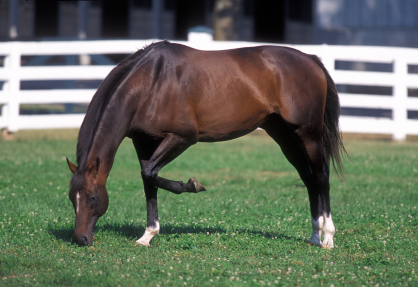 Turn them out to pasture is often considered the simple solution for preventing the return of equine gastric ulcers syndrome (EGUS) but for many, pasture just simply is not an option. This is particularly true when dealing with stallions. Few owners are prepared to take the risks associated with having stallions in turn out. This leaves many stallions in box stalls being managed in ways that increase their risk of developing EGUS. So what is it about this environment and management style that increases your stallion’s (or any horse’s for that matter) risk of developing EGUS? To answer that question requires some knowledge of the anatomy and physiology of the equine stomach.
Turn them out to pasture is often considered the simple solution for preventing the return of equine gastric ulcers syndrome (EGUS) but for many, pasture just simply is not an option. This is particularly true when dealing with stallions. Few owners are prepared to take the risks associated with having stallions in turn out. This leaves many stallions in box stalls being managed in ways that increase their risk of developing EGUS. So what is it about this environment and management style that increases your stallion’s (or any horse’s for that matter) risk of developing EGUS? To answer that question requires some knowledge of the anatomy and physiology of the equine stomach.
Stretching Your Hay Supply
October 23, 2012
Posted by Dr. Clair Thunes in Nutrition
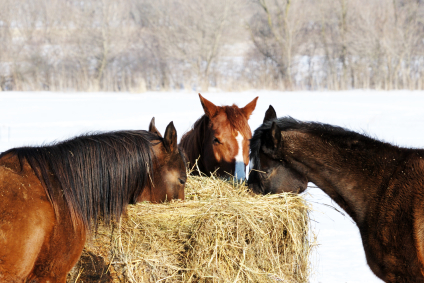 Forage should be the foundation of every horse’s ration. For most horses in the winter months this means hay and in certain locations where pasture is not practical in the summer hay has traditionally been the year long source of forage. However with some parts of the country reporting that only half the normal amount of hay was harvested and put up this year many owners are experiencing hay shortages and or high prices. This can be a particular challenge for breeders as broodmares and growing youngstock require high quality forage. Here are some ways that you can make the most of your hay budget and stretch what hay you do have in the barn this winter.
Forage should be the foundation of every horse’s ration. For most horses in the winter months this means hay and in certain locations where pasture is not practical in the summer hay has traditionally been the year long source of forage. However with some parts of the country reporting that only half the normal amount of hay was harvested and put up this year many owners are experiencing hay shortages and or high prices. This can be a particular challenge for breeders as broodmares and growing youngstock require high quality forage. Here are some ways that you can make the most of your hay budget and stretch what hay you do have in the barn this winter.
Feeding the Pregnant Mare
July 25, 2012
Posted by Dr. Clair Thunes in Nutrition
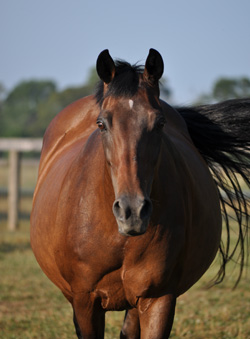 So you just received the results of the 14 day ultra sound and your mare is in foal; congratulations, you have successfully negotiated the first hurdle. Now for the long wait. In the meantime there is a lot to be done to help insure a healthy foal including feeding the mare correctly. But what exactly are a pregnant mares nutrient requirements? Pregnant mares must consume enough nutrients to both maintain their own body weight throughout the pregnancy and also to create new tissues; those of the fetus and those that support the pregnancy such as the placenta. Due to the very small amount of tissue deposition in the first months of pregnancy, providing the mare is in good weight and not working or lactating, she can be fed as a horse at maintenance for the first 4 months. However, due to the development of the tissues supporting the pregnancy, starting in month 5 her nutrient requirements change.
So you just received the results of the 14 day ultra sound and your mare is in foal; congratulations, you have successfully negotiated the first hurdle. Now for the long wait. In the meantime there is a lot to be done to help insure a healthy foal including feeding the mare correctly. But what exactly are a pregnant mares nutrient requirements? Pregnant mares must consume enough nutrients to both maintain their own body weight throughout the pregnancy and also to create new tissues; those of the fetus and those that support the pregnancy such as the placenta. Due to the very small amount of tissue deposition in the first months of pregnancy, providing the mare is in good weight and not working or lactating, she can be fed as a horse at maintenance for the first 4 months. However, due to the development of the tissues supporting the pregnancy, starting in month 5 her nutrient requirements change.
An Interview with Nutritional Consultant - Clair Thunes PhD
April 19, 2012
Posted by Dr. Clair Thunes in Nutrition
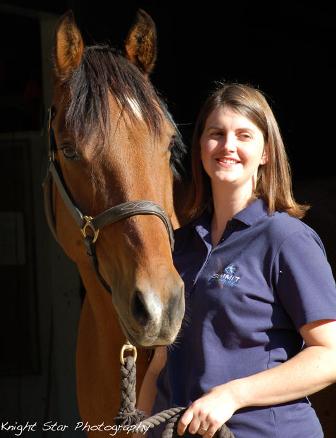 In previous newsletters we have included articles on several nutrition topics related to horse breeding written by the independent consultant, Clair Thunes of Summit Equine Nutrition. This month we took the opportunity to interview and introduce you to Clair and to discuss how working with a nutritional consultant can benefit your breeding program. Her clients cite many favorable reasons for incorporating a nutritional program on their farm, from the mares being in better condition on less feed to the foals looking better at weaning and therefore commanding higher prices when sold. But perhaps the biggest advantage is the peace of mind people report, knowing that they are feeding the right products and giving their foals the best start possible. Being able to tell prospective buyers that the farm works with a nutritionist and that the foals have a good nutritional foundation is also a great selling point.
In previous newsletters we have included articles on several nutrition topics related to horse breeding written by the independent consultant, Clair Thunes of Summit Equine Nutrition. This month we took the opportunity to interview and introduce you to Clair and to discuss how working with a nutritional consultant can benefit your breeding program. Her clients cite many favorable reasons for incorporating a nutritional program on their farm, from the mares being in better condition on less feed to the foals looking better at weaning and therefore commanding higher prices when sold. But perhaps the biggest advantage is the peace of mind people report, knowing that they are feeding the right products and giving their foals the best start possible. Being able to tell prospective buyers that the farm works with a nutritionist and that the foals have a good nutritional foundation is also a great selling point.
Feeding For Conception
November 30, 2011
Posted by Dr. Clair Thunes in Nutrition
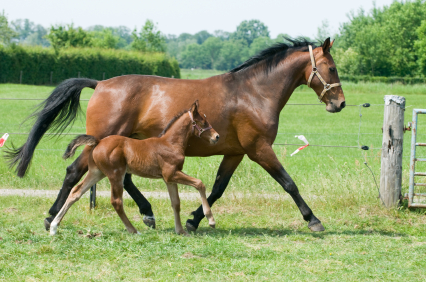 You have finally made your decision and the booking with Mr Right is made. In a few short months your mare will be bred to the stud of your dreams and all that is left now is to wait out the cold winter months and for spring to roll around. There is always that niggly question though, will she cycle and will she take? If there was just some way you could help the odds. Well you are in luck because there is. You can make sure that she is carrying an ideal amount of condition.
You have finally made your decision and the booking with Mr Right is made. In a few short months your mare will be bred to the stud of your dreams and all that is left now is to wait out the cold winter months and for spring to roll around. There is always that niggly question though, will she cycle and will she take? If there was just some way you could help the odds. Well you are in luck because there is. You can make sure that she is carrying an ideal amount of condition.
Feeding Decisions for Weanlings
September 28, 2011
Posted by Dr. Clair Thunes in Nutrition
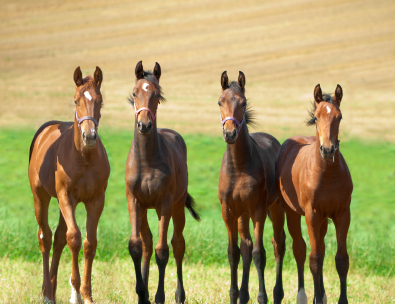 How you feed your foal once weaned depends a lot on breed and your future goals. Is your weanling destined for the sales or show ring, expected to race as a 2 year old, or will he be maturing slowly at home until going under saddle as a 4 year old? Is he a breed typically considered to be an easy keeper and at risk of getting fat or a higher calorie burning thoroughbred? No matter the breed or ultimate goal, two things are sure; growth needs to be steady and the diet needs to be made up of balanced, high quality, easily assimilated nutrients.
How you feed your foal once weaned depends a lot on breed and your future goals. Is your weanling destined for the sales or show ring, expected to race as a 2 year old, or will he be maturing slowly at home until going under saddle as a 4 year old? Is he a breed typically considered to be an easy keeper and at risk of getting fat or a higher calorie burning thoroughbred? No matter the breed or ultimate goal, two things are sure; growth needs to be steady and the diet needs to be made up of balanced, high quality, easily assimilated nutrients.
Taking the Stress Out of Weaning
June 28, 2011
Posted by Dr. Clair Thunes in Nutrition
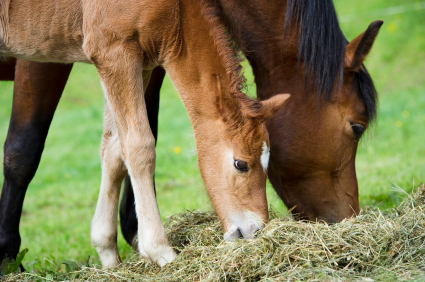 Heading into summer many of you will be contemplating the process of weaning your foals. Typically foals are weaned between 4-6 months of age and the process used is often dictated by the facilities available. Careful planning will reduce stress and set your foal up for success. Obviously the biggest change for your foal will be the loss of contact with its mother followed by the change in diet. At birth the foal’s sole source of nutrition is provided by the mare’s milk which at its peak can amount to 3% of her body weight per day. Over time the foal’s digestive tract matures. Bacteria are picked up from the environment and populate the hindgut. This provides the foal with the ability to start digesting more complex feeds such as pasture, quality hay or some other supplemental feed.
Heading into summer many of you will be contemplating the process of weaning your foals. Typically foals are weaned between 4-6 months of age and the process used is often dictated by the facilities available. Careful planning will reduce stress and set your foal up for success. Obviously the biggest change for your foal will be the loss of contact with its mother followed by the change in diet. At birth the foal’s sole source of nutrition is provided by the mare’s milk which at its peak can amount to 3% of her body weight per day. Over time the foal’s digestive tract matures. Bacteria are picked up from the environment and populate the hindgut. This provides the foal with the ability to start digesting more complex feeds such as pasture, quality hay or some other supplemental feed.
Feeding The Breeding Stallion
April 12, 2011
Posted by Dr. Clair Thunes in Nutrition
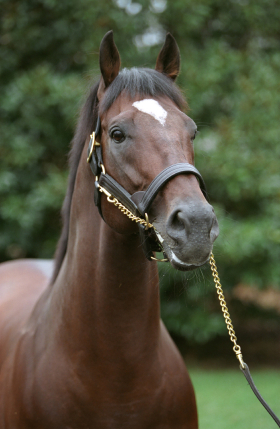 Stallions are the Hollywood stars of the breeding world. Their presence is hard to ignore. Yet behind the glamour persona, there is a job to be done. Combined with the costs of promoting a stallion, the pressure on stallion owners and managers to insure their charges are at the top of their game and able to perform on demand when brought to the breeding shed, becomes evident. The stallion himself is not exempt from feeling this stress. The life of a breeding stallion with a full book can be hard work, and may take its toll on an ill prepared stud. Nutrition plays a key role in insuring that your stallion has the best chance of a successful breeding season.
Stallions are the Hollywood stars of the breeding world. Their presence is hard to ignore. Yet behind the glamour persona, there is a job to be done. Combined with the costs of promoting a stallion, the pressure on stallion owners and managers to insure their charges are at the top of their game and able to perform on demand when brought to the breeding shed, becomes evident. The stallion himself is not exempt from feeling this stress. The life of a breeding stallion with a full book can be hard work, and may take its toll on an ill prepared stud. Nutrition plays a key role in insuring that your stallion has the best chance of a successful breeding season.
Please Note - photos used in these news articles are available in the public domain, have been purchased through istockphoto or (when referencing breeders or horses) have been submitted to Select Breeders Services Inc. by the breeding farm or horse owner. Photo credit has been provided where applicable. If at anytime you see something that needs to be addressed please feel free to contact us directly.
- Categories
- Affiliate News
- Breeding with Frozen Semen
- Contract Considerations
- Disease and Health Testing
- Embryo Transfer
- Foal and Neonate Care
- Focus On Our Breeders
- Frozen Semen
- General Interest
- Genetics
- Guidelines
- Import and Export
- Industry News
- Mare Management
- Nutrition
- Stallion Management
- _Archived Articles
- Contributors
- Andrew Swenson
- Chad Mendell
- Clair Thunes, PhD
- Don Kapper
- Dr. Anna Toenissen
- Dr. Brian Carroll
- Dr. Carleigh Fedorka, PhD
- Dr. Clair Thunes
- Dr. Dave Scofield
- Dr. Ed Squires
- Dr. Ed Squires and Dr. Pat McCue
- Dr. Elena Martinez de Andino
- Dr. Erin Newkirk
- Dr. Gabe Young
- Dr. Glenn Blodgett
- Dr. Holly Mason
- Dr. Igor Canisso
- Dr. Jed McKinlay
- Dr. Jerry Longworth
- Dr. Jessica Quigg
- Dr. Karen Wolfsdorf
- Dr. Margo Macpherson
- Dr. Maria Schnobrich
- Dr. Nikki Collins
- Dr. Phil Matthews
- Dr. Regina Turner
- Dr. Richard Giacopuzzi
- Dr. Robert Franklin
- Dr. Ryan Ferris
- Dr. Sandro Barbacini
- Dr. Stephanie Walbornn
- Dr. Stuart Meyers
- Dr. Ute Pansegrau
- Erin Bishop
- Erin Bishop, MS
- Julie Fershtman
- Julie Skaife
- Karen Wolfsdorf, DVM Dipl ACT
- Karen Wolfsdorf, DVM, DACT
- Laura Patterson Rosa, DVM, Ph.D.
- MR Petersen and AM Bojesen
- Mallory Canaday
- Meredith Bonnell, MS
- Michelle Regan
- Natalie DeBerardinis
- Old Dominion Hemp
- Paul Loomis
- Quinnten Alston
- Rood and Riddle Equine Hospital
- S.A. Brooks and L. Patterson-Rosa
- SBS
- SBS-MD
- SBSI
- SBSW
- Recent Posts
- Saving the Poitou Donkey
- Squires Awarded 2024 ISER Pioneer Award
- 2023 SBS Foal Photo Contest Winner
- Leah Lively: Her ICSI Journey
- International Symposium on Equine Reproduction – Dr. Ed Squires Recognized as Honorary Chair
- Dr. Phil Matthews of PetersonSmith Retires
- Congenital Hypothyroidism
